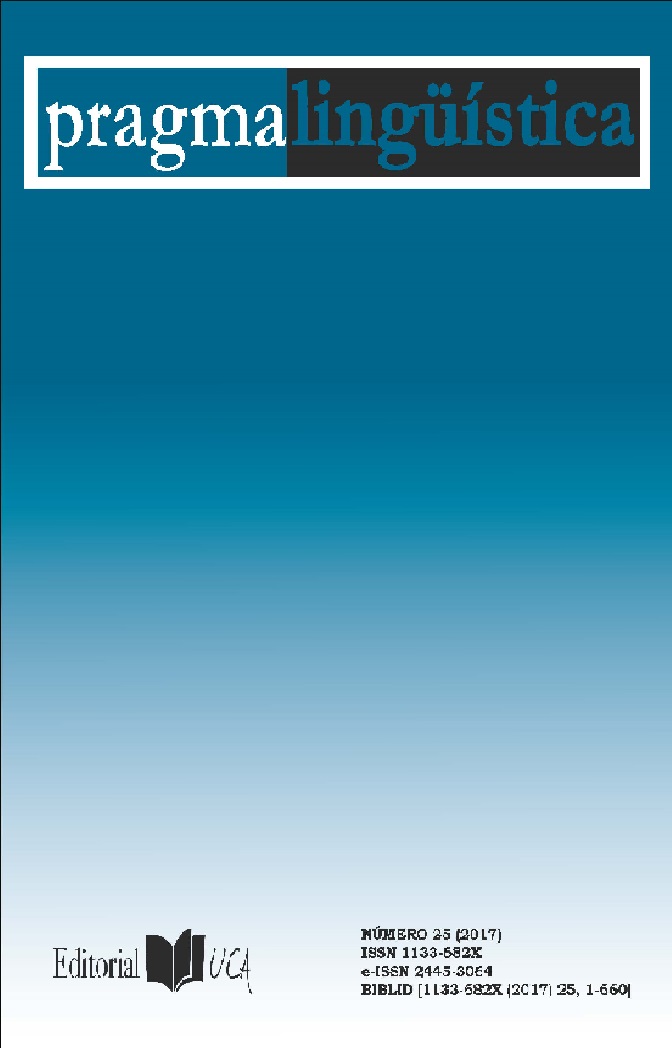Hacia la Lingüística realista de Katz

DOI
https://doi.org/10.25267/Pragmalinguistica.2017.i25.25Información
Resumen
Este artículo presenta y defiende la lingüística realista propuesta por Katz. Él considera que la lingüística es una ciencia formal, que es parte de las matemáticas, y que es una ciencia que trata con objetos abstractos que son las lenguas naturales. Es, entonces, una propuesta realista (platonista) porque argumenta que los objetos abstractos son reales, aunque no son iguales a los objetos concretos como las mesas y los gatos. La propuesta de Katz no ha sido seriamente considerada en lingüística. Probablemente, porque suena extraña desde una perspectiva lingüística. Argumentamos que, sin embargo, debe ser seriamente considerada. Puede no ser la mejor teoría posible, pero se presenta como una opción interesante. Este artículo intenta mostrar cuál es la propuesta de Katz, cuáles son algunos de sus problemas y limitaciones, así como intenta defender que considerarla seriamente nos ayuda a pensar en las lenguas naturales de una manera diferente.
Palabras clave
Descargas
Cómo citar
Licencia
Derechos de autor 2018 Pragmalingüística

Esta obra está bajo una licencia internacional Creative Commons Atribución-NoComercial-CompartirIgual 4.0.
Citas
BEHME, C. (2012): “The Essence of Postal’s Criticism: A short reply to Ulfsbjorninn (2012) - an update”, Publicación electrónica: http://ling.auf.net/ling-buzz/001573.
BENACERRAF, P. (1965): “What Numbers Could Not Be”, The Philosophical Review, 74(1), pp. 4773.
CHOMSKY, N. (1986): Knowledge of language: Its nature, origin, and use, Westport/ Connecticut/ London: Praeger.
CHOMSKY, N. (1987): “Reply”, Mind and language. Vol. 2. Summer 1987, pp. 178-197.
CHOMSKY, N. (2012): The Science of Language, Cambridge: Cambridge University Press.
DEAHENE, S. (2011): The Number Sense: How the Mind Creates Mathematics, Revised and Updated Edition, Oxford: Oxford University Press.
EVERETT, D. (2005): “Cultural constraints on grammar and cognition in Piraha”, Current Anthropology 46, pp. 621-646.
FODOR, J. (1981): “Some notes on what linguistics is about“, Block (ed) 1981 Readings in Philosophy of Psychology, Vol. 2, Cambridge, Massachusetts: Harvard University Press, pp. 197-207.
GEORGE, A. (1987): “Review Discussion”, Mind and Language, vol. 2, pp. 155-164.
HARRIS, R. (1993): The linguistics wars, New York/ Oxford: Oxford University Press.
HOPPER, P. & TRAUGOTT, E. (1993): Gramaticalization, Cambridge/ New York/ Melborune: Cambridge University Press.
HURFORD, J. (2014): The origins of language: a slim guide, Oxford: Oxford University Press.
JENKINS, L. (2003): Biolinguistics: explaining the biology of language, Cambridge/ New York/ Port Melbourne: Cambridge University Press (Virtual Publishing).
KATZ, J. (1977): “The Real Status of Semantic Representations”, Block (ed) (1981) Readings in Philosophy of Psychology, Vol. 2, Cambridge, Massachusetts: Harvard University Press, pp. 253-275.
KATZ, J. (1981): Language and other abstract objects, New Jersey: Rowman and Littlefield.
KATZ, J. (1985): “An outline of pla-tonist grammar”, The Philosophy of Linguistics, Oxford: Oxford University Press.
KATZ, J. (1996): “The unfinished Chomskyan Revolution”, Mind and Language, Vol. 11. No. 3 September 1996, pp. 270-294.
KATZ, J. (1998): Realistic Rationalism, United States of America, MIT Press.
KATZ, J. & POSTAL, P. (1991): “Realism vs Conceptualism in Linguistics”, Linguistics and Philosophy 14, pp. 515-554.
KINGSTON, J. (2007): “The phoneticsphonology interface”, De Lacy, P. (ed). The Cambridge Handbook of Phonology, New York: Cambridge University Press, pp. 401-434.
LANGENDOEN, T & POSTAL, P. (1984): The vastness of natural languages, Oxford: Basil Blackwell.
LAURENCE, S. (2003): “Is Linguistics a branch of psychology?”, Barber, A (Ed) Epistemology of language, Oxford: Oxford University Press, pp. 69-106.
LIFE, J. (2015): A biopsychological foundation for linguistics. Tesis de doctorado defendida en septiembre de 2015, en The University of Western Ontario, Publicación electrónica: http://ir.lib.uwo.ca/etd/3205 /.
LOWE, E. J. (2001): The Possibility of Metaphysics: Substance, Identity, and Time, Oxford: Clarendon Press.
NEVINS, A; PESETSKY, D. & C. RODRIGUES (2009a): “Piraha exceptionality: A reassessment”, Language 85,pp.355-404.
NEVINS, A; D. PESETSKY & RODRIGUES, C. (2009b): “Discussion Note: Evidence and ar-gumetation: A reply to Everett (2009)”, Language, vol. 85, nro. 3, pp. 671-681.
PARTEE, B. H. (2014): “A brief history of the syntax-semantics interface”, Western formal linguistics. Semantics-Syntax Interface 1(1), pp. 1-21.
POSTAL, P. (2003): “Remarks on the foundation of linguistics”. The Philosophical Forum, Vol. XXIV, Nos 3 & 4, Fall/Winter, 2003, pp. 233-252.
POSTAL, P. (2004): Skeptical Linguistic Essays, Oxford: Oxford University Press.
SAUERLAND, U. (2010) “Experimental evidence for complex syntax in Pirahá”, Publicación electrónica: http://www.zas.gwz-ber-lin.de/574.html?&L=1.
SAUSSURE, F. (1916): Cours de linguistique générale, Paris, Payot [1995].
SEARLE, J. (1980): “Minds, brains, and programs”, Behavioral and Brain Sciences 3 (3), pp. 417-457.
TRUBETZKOY, N. S. (1939): Grundziige der phonologic. Travaux du cercle linguistique de Prague, 1. Traducción al español por Delia García Giordano con la colaboración de Luis J. Prieto. Madrid: Cincel [1973].
TURING, A. (1950): “Computing Machinery and Intelligence”, Mind, New Series, Vol. 59, No. 236 (Oct., 1950), pp. 433-460.






